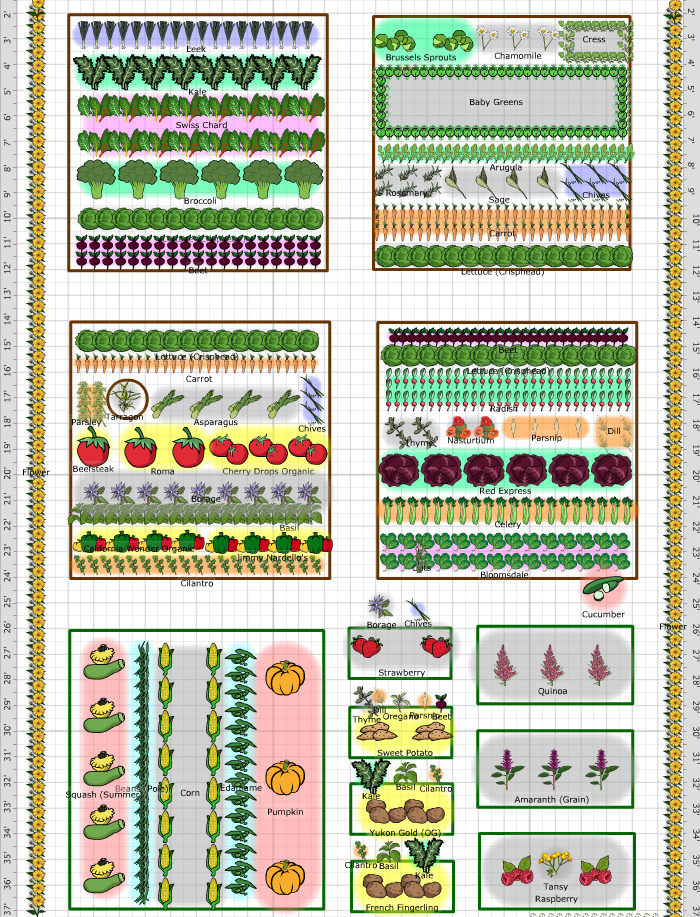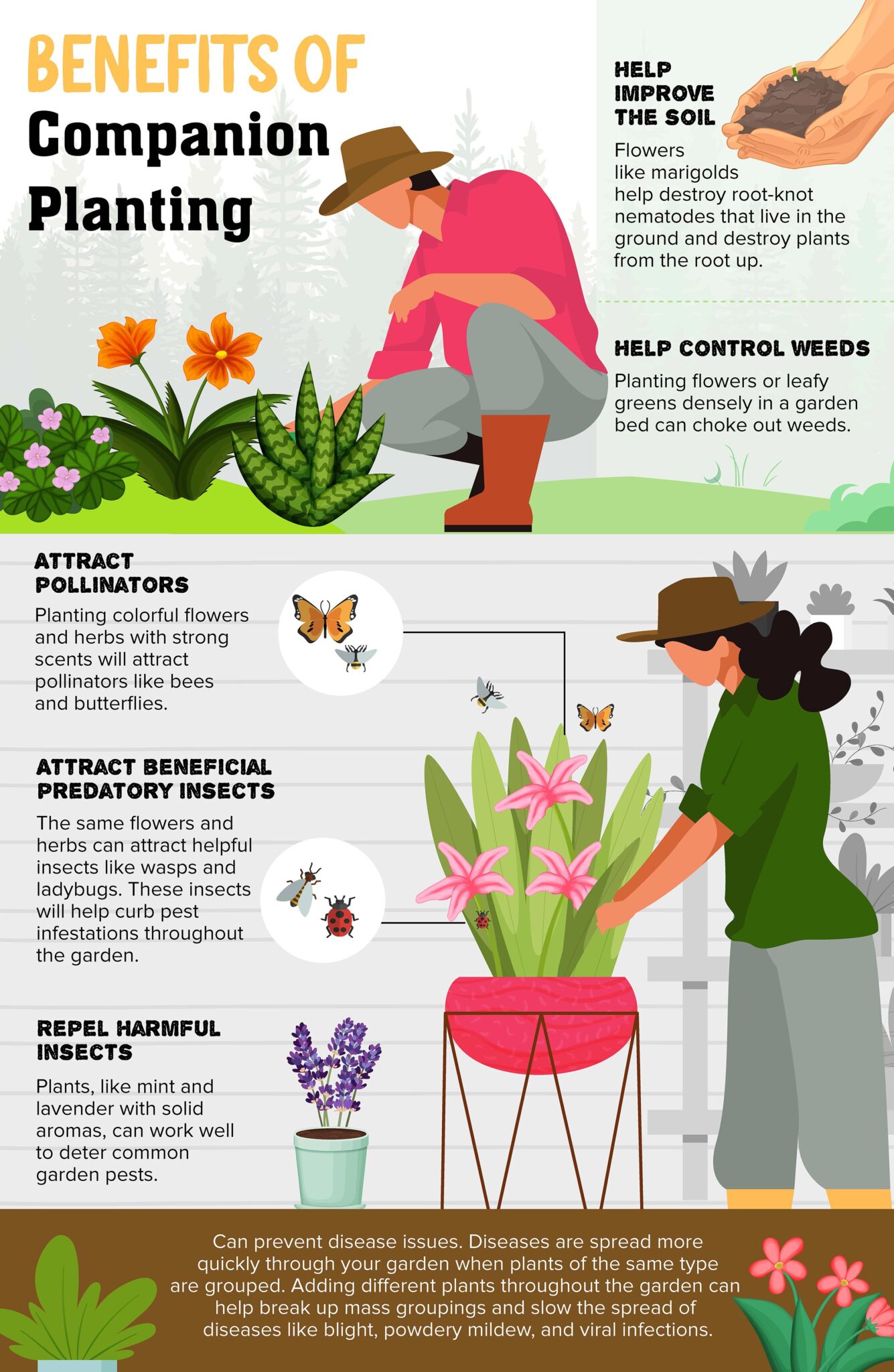The Ultimate Companion Planting Garden Plan
The Ultimate Companion Planting Garden Plan
Companion planting is a gardening technique that involves planting certain plants together to benefit each other. By carefully considering the plants you grow and how they interact, you can create a garden that is more productive, pest-resistant, and healthy.
In this blog post, we will discuss the benefits of companion planting and provide you with a comprehensive guide to planning your own companion planting garden. We will cover everything from choosing the right plants to spacing them properly to harvesting your bounty.
Benefits of Companion Planting
There are many benefits to companion planting. Some of the most common benefits include:
- Increased productivity: Companion plants can help to improve the growth and yield of other plants. For example, beans fix nitrogen in the soil, which can benefit other plants that need nitrogen.
- Reduced pest and disease pressure: Companion plants can help to repel pests and diseases. For example, marigolds are known to repel nematodes, which can damage root crops.
- Improved soil health: Companion plants can help to improve the overall health of your soil. For example, legumes (such as beans) add nitrogen to the soil, while other plants can help to suppress weeds and improve drainage.
- Attract beneficial insects: Companion plants can attract beneficial insects, such as ladybugs and bees, which can help to control pests.
- Create a more aesthetically pleasing garden: Companion planting can also create a more visually appealing garden. For example, you can plant flowers among your vegetables to add color and interest.
How to Plan a Companion Planting Garden
When planning a companion planting garden, there are a few things you need to keep in mind. First, you need to consider the needs of the plants you want to grow. Some plants need full sun, while others prefer partial shade. Some plants need well-drained soil, while others prefer moist soil. Once you know the needs of your plants, you can start to think about which plants would complement each other.
There are many resources available to help you with companion planting. You can find books, websites, and even apps that can provide you with information on which plants to grow together. Once you have a few ideas, you can start to sketch out a plan for your garden.
When planting your companion garden, it is important to consider the spacing of the plants. Some plants need more space than others. You also need to make sure that you plant the taller plants in the back of the garden and the shorter plants in the front. This will help to ensure that all of your plants get the sunlight they need.
Harvesting Your Companion Planting Garden
Once your companion planting garden is in full swing, you will start to reap the rewards. You can harvest your vegetables and fruits as they mature. You can also enjoy the beauty of your flowers and the beneficial insects that they attract.
Companion planting is a great way to grow a more productive, pest-resistant, and healthy garden. By following the tips in this blog post, you can create a companion planting garden that will be a source of joy and satisfaction for years to come.
Are you looking to grow a healthy and productive garden? If so, you may want to consider companion planting. Companion planting is a gardening technique that involves planting certain plants together to benefit each other. For example, some plants can attract beneficial insects that help to control pests, while others can improve the soil quality or provide shade for more delicate plants.
If you're new to companion planting, you can find a wealth of information on the Garden Wiki. This website has a comprehensive guide to companion planting, including a list of compatible plants, tips for planning your garden, and even a garden planner tool.
The Garden Wiki team is also passionate about helping gardeners succeed. They offer a variety of resources, including blog posts, articles, and videos, all of which are designed to make companion planting easier and more enjoyable.
So if you're ready to take your gardening to the next level, I encourage you to visit Garden Wiki. You won't be disappointed.
FAQ of companion planting garden plan
- What are the benefits of companion planting?
Companion planting is a gardening technique that involves planting certain plants together to improve their growth and health. There are many benefits to companion planting, including:
* Attracting beneficial insects and pollinators: Some companion plants, such as marigolds and nasturtiums, attract beneficial insects and pollinators, which can help to control pests and improve pollination.
* Distracting pests: Other companion plants, such as nasturtiums, can be used to distract pests away from other plants.
* Enhancing soil quality: Some companion plants, such as legumes, can fix nitrogen in the soil, which can benefit other plants.
* Shading and wind protection: Some companion plants, such as sunflowers and corn, can provide shade and wind protection for other plants.
* Complementing each other's needs: Some companion plants have complementary needs, such as needing different amounts of water or nutrients. By planting these plants together, you can help them to thrive.
- How do I choose companion plants?
There are many resources available to help you choose companion plants. You can find companion planting charts online or in gardening books. These charts will show you which plants are compatible with each other. You can also talk to experienced gardeners or visit your local nursery for advice.
When choosing companion plants, it is important to consider the following factors:
* The plants' needs: Make sure that the plants you choose have similar needs in terms of sunlight, water, and nutrients.
* The plants' growth habits: Some plants, such as tomatoes, grow tall and need plenty of space. Other plants, such as lettuce, grow low to the ground and can be planted closer together.
* The plants' pests and diseases: Some plants are susceptible to the same pests and diseases. By planting these plants together, you can make it more difficult for pests and diseases to spread.
- How do I plant companion plants?
When planting companion plants, it is important to follow the instructions on the plant tags. In general, you should plant companion plants the same way you would plant any other plant. However, there are a few things to keep in mind:
* Plant compatible plants together. Make sure that the plants you are planting are compatible with each other.
* Plant the right distance apart. Some plants need more space than others. Make sure to plant your plants the appropriate distance apart.
* Water your plants regularly. All plants need water to survive. Make sure to water your companion plants regularly, especially during hot, dry weather.
- How do I care for companion plants?
The care requirements for companion plants vary depending on the type of plants you are growing. However, there are some general care tips that you can follow:
* Water your plants regularly. All plants need water to survive. Make sure to water your companion plants regularly, especially during hot, dry weather.
* Fertilize your plants. Most plants benefit from regular fertilization. You can use a balanced fertilizer or a fertilizer specifically designed for vegetables.
* Protect your plants from pests and diseases. Keep an eye out for pests and diseases and take steps to control them if necessary.
* Weed your garden regularly. Weeds can compete with your plants for water and nutrients. Weed your garden regularly to keep weeds under control.
- What are some common mistakes to avoid when companion planting?
Here are a few common mistakes to avoid when companion planting:
* Planting incompatible plants together. Make sure to do your research and plant compatible plants together.
* Planting plants too close together. Some plants need more space than others. Make sure to plant your plants the appropriate distance apart.
* Not watering your plants regularly. All plants need water to survive. Make sure to water your companion plants regularly, especially during hot, dry weather.
* Not fertilizing your plants. Most plants benefit from regular fertilization. You can use a balanced fertilizer or a fertilizer specifically designed for vegetables.
* Not protecting your plants from pests and diseases. Keep an eye out for pests and diseases and take steps to control them if necessary.
Image of companion planting garden plan
5 different images of "companion planting garden plan" from Pinterest:
- A simple companion planting plan for a raised bed garden. This plan shows how to plant tomatoes, peppers, cucumbers, zucchini, and beans in a 4x8 foot raised bed. The plants are arranged so that they benefit each other, such as tomatoes and basil, which repel pests.

- A more complex companion planting plan for a backyard garden. This plan shows how to plant a variety of vegetables, herbs, and flowers in a 10x10 foot space. The plants are arranged so that they take advantage of each other's strengths, such as carrots and onions, which help to repel each other's pests.

- A companion planting plan for a container garden. This plan shows how to plant tomatoes, peppers, herbs, and lettuce in a variety of containers. The plants are arranged so that they can thrive in the limited space of a container garden.

- A companion planting plan for a small garden. This plan shows how to plant a variety of vegetables, herbs, and flowers in a small space, such as a patio or balcony. The plants are arranged so that they can grow well in the limited space and provide a variety of food and flowers.

- A companion planting plan for a specific purpose. This plan shows how to plant a garden specifically for attracting pollinators, such as bees and butterflies. The plants are arranged so that they provide food and nectar for these beneficial insects.

Post a Comment for "The Ultimate Companion Planting Garden Plan"